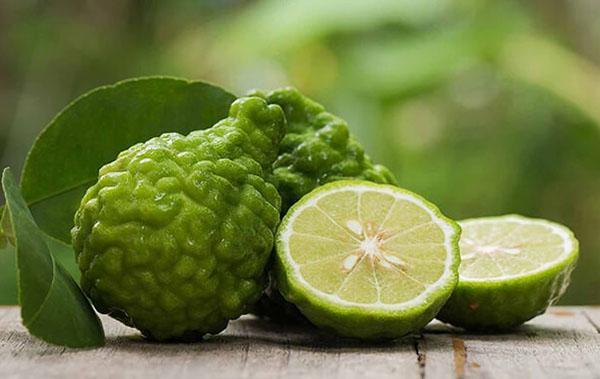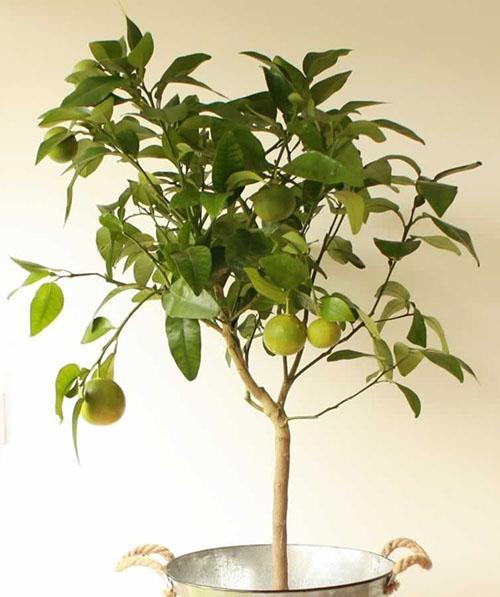We can do it - growing bergamot at home
 Growing bergamot at home, which came to us from Southeast Asia, is not at all difficult. There are several types of this plant, which differ in size and deciduous plates.
Growing bergamot at home, which came to us from Southeast Asia, is not at all difficult. There are several types of this plant, which differ in size and deciduous plates.
Tree, flowers and fruits - external description

Before drying bergamot, remember to do this only in the shade.
Crown characteristic
 Bergamot is characterized by a spreading and wide crown. The shoots of the tree are quite thick, they stretch up from the main trunk. On the branches there are thorns of an impressive size - up to 10 cm long. The leaves have a specific aroma. They look like a pointed ellipse, deep green in color.
Bergamot is characterized by a spreading and wide crown. The shoots of the tree are quite thick, they stretch up from the main trunk. On the branches there are thorns of an impressive size - up to 10 cm long. The leaves have a specific aroma. They look like a pointed ellipse, deep green in color.
Features of peduncles
 Potted bergamot blooms in the first month of spring. The loose buds have a rich, fragrant aroma. They can be light cream or fuchsia. Flowers are often solitary, in rare cases, collected in inflorescences.
Potted bergamot blooms in the first month of spring. The loose buds have a rich, fragrant aroma. They can be light cream or fuchsia. Flowers are often solitary, in rare cases, collected in inflorescences.
Fruiting plants
At the very end of autumn or in December, the plant bears fruit. The ripe fruit looks like a ball. It has a dense shell consisting of three layers. Seeds are dark in color. The pulp is divided into separate segments. It tastes rather sour, but very aromatic.
Bergamot species
Growing several types of bergamot indoors, you will not only improve the design of the room, but also receive useful fruits as a gift.
Garden bergamot or Monarda
 The presented species belongs to the family of Labiates or Lambes. It is a herb that can be both annual and perennial. The root system is well developed. Such bergamot grows up to 1.5 meters high. Stems are straight, strongly branching. Leaves are simple, slightly toothed, oblong lanceolate.
The presented species belongs to the family of Labiates or Lambes. It is a herb that can be both annual and perennial. The root system is well developed. Such bergamot grows up to 1.5 meters high. Stems are straight, strongly branching. Leaves are simple, slightly toothed, oblong lanceolate.
Due to its pleasant taste, the plant is in special demand among culinary specialists. Leaves and fruits are used to prepare various dishes, vermouth.
The peculiarity of Monarda is that its leaves have a bright aroma both fresh and dried.
Bergamot flowers are beautiful and smell good. They are often used to decorate desserts. The inflorescences are colorful, up to 7 cm in diameter. In some Monarda varieties, they are arranged in two tiers. Flowers can be of various shades: light yellow, snow-white, pink, deep purple, red, as well as unusual speckled.
Orange bergamot
 This hybrid member belongs to the root family. Citrus-bergamot is not found in the wild, it is not a creation of nature, but of man.
This hybrid member belongs to the root family. Citrus-bergamot is not found in the wild, it is not a creation of nature, but of man.
The bergamot orange was developed by crossing citron and orange.
As a result of selection, an evergreen tree was obtained, capable of growing from 2 to 10 m in height. The branches are quite long. All of them are covered with spines about 10 cm in size. Leaves are shiny, emerald green. They are distinguished by an oblong, slightly ovoid shape.
The flowers are large. They often take on a snow-white or purple hue. The fruits are not large, resemble in shape pear, with a thick skin.In the middle of each fruit are dark-colored seeds. The pulp is divided into parts. When the fruits are ripe, they have an unusual sour taste. Because of this, whole plantations are planted with bergamot orange in Argentina, Brazil, the USA and in one of the Italian provinces of Calabria.
Growing bergamot at home
 In order for a fragrant plant to bear tasty fruits and delight with its beauty, it is necessary to understand the rules of care, the optimal planting time and growth characteristics.
In order for a fragrant plant to bear tasty fruits and delight with its beauty, it is necessary to understand the rules of care, the optimal planting time and growth characteristics.
Lighting and optimal location
During the growing season, bergamot requires good lighting. The culture loves warmth and requires up to 10 hours of daylight hours. Therefore, you need to choose the right place for planting bergamot. It should be sunny. An excellent option is windows that face the east or west side. At the height of summer, the crown needs protection from the scorching rays, so it is better to cover the windows with curtains. If you do not do this, the plant will get burned and look unattractive.
Required temperature indicators
The growing season of bergamot is spring and summer. The plant feels great at temperatures from +25 to +350 C. For fruits to set, during flowering bergamot should be kept in a room with indicators from +18 to +250 FROM.
Irrigation and humidification
Bergamot care also includes timely watering. This is especially true in warm weather, when the ground dries out quickly. It is necessary to irrigate the fragrant plant every 3 or 5 days. If the house does not have an air conditioner, and the temperature is high for a long time, then the number of procedures is increased.
Breeding features
 The plant is propagated by cuttings or using seeds. The most favorable temperature indicators for this procedure - +25 - +280 FROM.
The plant is propagated by cuttings or using seeds. The most favorable temperature indicators for this procedure - +25 - +280 FROM.
Bergamot is suitable for places without drafts, protected from the wind. The plant is completely undemanding to soil.
Planting a bush
 For reproduction, adult specimens are chosen. The mother bush is dug up, divided into several parts, which are then planted in a permanent place. Using this breeding method, the flowering of the bush occurs in the year of planting.
For reproduction, adult specimens are chosen. The mother bush is dug up, divided into several parts, which are then planted in a permanent place. Using this breeding method, the flowering of the bush occurs in the year of planting.
Plant cuttings
 To get cuttings, you need to take a sharp knife. From the top of the branches, specimens are cut into 15 cm long. They are dipped in a solution to stimulate growth, then planted. For rooting cuttings, a darkened place is selected.
To get cuttings, you need to take a sharp knife. From the top of the branches, specimens are cut into 15 cm long. They are dipped in a solution to stimulate growth, then planted. For rooting cuttings, a darkened place is selected.
It is necessary to make recesses in containers, on the bottom of which drainage should be laid. Then sprinkle everything on top with a mixture of soil and sand, which are taken in equal volumes. After that, the cuttings treated with the stimulant are planted. For quick rooting, it is recommended to cover each of them with a glass jar. After a month, the seedlings are transplanted to a permanent place.
Planting seeds
 To grow the bergamot plant at home and in the open field, the seed method is also used. To get a healthy young plant, it is necessary to place the grains in a potting mixture prepared from humus and some sand. The seeds are buried no more than 1 cm. After sowing, the earth is moistened, the containers are placed in a polyethylene greenhouse.
To grow the bergamot plant at home and in the open field, the seed method is also used. To get a healthy young plant, it is necessary to place the grains in a potting mixture prepared from humus and some sand. The seeds are buried no more than 1 cm. After sowing, the earth is moistened, the containers are placed in a polyethylene greenhouse.
If the temperature is maintained at +200 C, then in such conditions bergamot seeds will germinate well, each of them will form 4 sprouts. It takes a little more than a month to hatch them. As soon as green shoots appear above the surface of the soil, the greenhouse is opened slightly to provide the plant with an influx of fresh air. When the bergamot seedlings get stronger, they are planted in separate flowerpots. This growing method is suitable for both indoor options and garden decoration. A month after planting seedlings, bergamot will become a real decoration of the house.
Bergamot, with proper attention and adherence to the rules of cultivation, will grow into a two-meter citrus tree.It will delight not only with its interesting decorative appearance and beautiful foliage, but also with incredibly fragrant flowers. And after flowering, it will bear fruit that can be usefully used in cooking and for cosmetic purposes.
Hello.
I would like to ask you for help. I germinated bergamot from the seed, at the end of February, in a large container, transplanted at the beginning of November. The lower leaves suffered during the adoption after the greenhouse. I can't find information about pruning young shoots, should I do it, at what time of the year and at what age? Rostock is the only one, I'm very afraid to do something wrong and thereby ruin him. I’m grateful for your advice. Thank you in advance!
Unfortunately, I cannot share my personal experience, because I have not grown anything except lemon and orange. However, on the Internet, I managed to find a little information about pruning young bergamot, I hope it will help you.
To accelerate the formation of lateral branches, on which fruit ovaries will be tied, the bush must be formed "from childhood". In the first year, the stem is shortened at a height of 15 cm. When lateral shoots appear, they are allowed to grow up to a maximum of 25 cm and are also shortened. The branches of the second order are cut, leaving a length of up to 10 cm.The branches that have grown from the buds on the left shoots are cut off when they reach 5 cm.
And some more interesting things. Bergamot is formed in the first 2-3 years. If a bush on new shoots forms 3-4 buds, then everything is just fine. If only one wakes up, you need to cut the main trunk of the bergamot before the fork.
Thank you very much, at this stage of growth, I think that's quite enough.